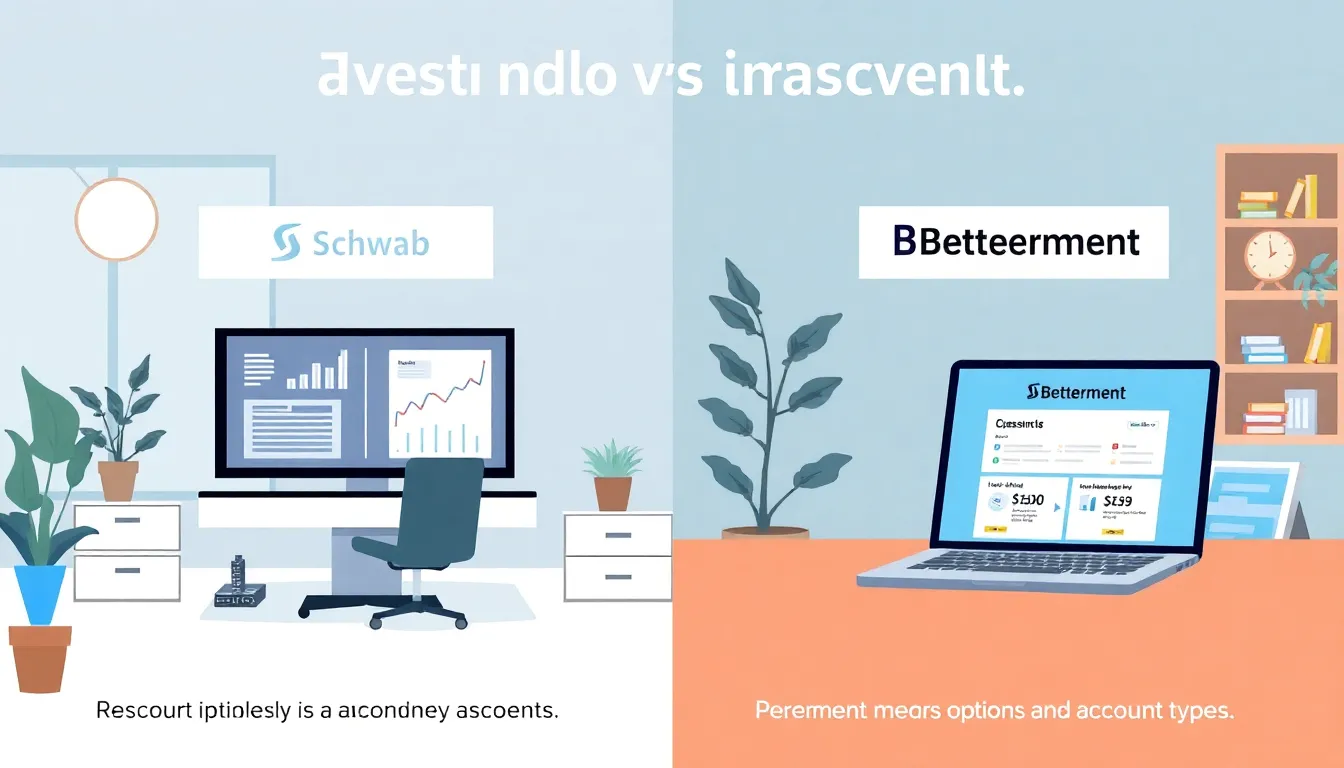Table of Contents
ToggleWhen it comes to investing, choosing the right platform can feel like picking a favorite child—impossible! Schwab and Betterment are two heavyweights in the ring, each boasting unique strengths that could make any investor weak in the knees. Whether you’re a seasoned pro or just dipping your toes into the investment pool, understanding the nuances between these two can save you from a financial faceplant.
Schwab brings a buffet of investment options and personalized service, while Betterment serves up a streamlined, robo-advisory experience that’s hard to resist. With both vying for your hard-earned cash, which one will take the crown? Buckle up as we dive into the nitty-gritty of Schwab vs. Betterment, helping you make an informed choice that’ll have your portfolio dancing with joy.
Overview of Schwab and Betterment
Schwab stands out as a full-service brokerage offering diverse investment options. It features access to stocks, bonds, ETFs, and mutual funds, catering to various investor needs. Personalized service is a key strength, with financial advisors available to assist clients.
In contrast, Betterment specializes in a robo-advisory experience, focusing on automated portfolio management. This platform emphasizes simplicity and ease of use, making it appealing to novice investors. Customized investment strategies based on individual goals enhance the user experience.
Fees differ significantly between the two. Schwab features no account minimums and zero commission trades for stocks and ETFs. Betterment offers tiered pricing, which includes a 0.25% annual management fee for traditional accounts. Each platform provides transparency regarding costs, helping investors plan accordingly.
Schwab’s robust investment research tools empower users to make informed decisions. From in-depth market analysis to performance tracking, these resources offer valuable insights. Betterment, however, emphasizes goal-setting and financial planning tools, assisting users in reaching their personal investment objectives.
Both platforms cater to different investor profiles. Schwab appeals to those seeking a comprehensive investment experience with a personal touch. Conversely, Betterment suits individuals looking for a hands-off approach to investment management. Understanding each platform’s strengths equips users to choose the option that aligns best with their financial goals.
Key Features Comparison

Investors can appreciate the distinct offerings of Schwab and Betterment in terms of investment options and account types.
Investment Options
Schwab provides a broad spectrum of investment choices. It includes stocks, bonds, ETFs, and mutual funds. Investors can access various asset classes, allowing a personalized approach to portfolio construction. Betterment, however, focuses on ETFs in its automated portfolios. It selects diverse ETFs to align with client risk tolerances and investment goals. Investors benefit from Betterment’s automatic rebalancing, ensuring portfolios remain aligned with their strategies. Each platform’s structure allows different degrees of control to cater to unique investor needs.
Account Types
Schwab features multiple account types, including individual, joint, and retirement accounts. Investors can choose from taxable and tax-advantaged options. It accommodates various investment styles and purposes. Conversely, Betterment offers simpler account types: standard taxable accounts and traditional or Roth IRAs. The ease of setup paired with low minimums appeals to beginners. Betterment’s focus on goal-based investing emphasizes saving for specific objectives, which distinguishes it from Schwab’s extensive account variety.
Fees and Expenses
Understanding the fee structures of Schwab and Betterment is essential for investors. Each platform has distinct costs that influence investment decisions.
Schwab Fees
Schwab’s fee structure includes zero account minimums and no commissions for trades on stocks and ETFs. Investors benefit from access to comprehensive research tools without incurring trading fees. A commission also applies to mutual funds, typically $49.95 per trade. Monthly maintenance fees may arise for certain account types. However, Schwab notably eliminates many of these fees for investors opting for electronic statements or those meeting specific account balance requirements. This approach provides cost-effective options, especially for regular traders.
Betterment Fees
Betterment implements a tiered pricing model, charging a 0.25% annual management fee for standard accounts. Investors with more significant assets might choose the premium plan, which has a 0.40% fee and includes additional advice from certified financial planners. Betterment’s fee includes all investment expenses, which simplifies cost management for users. Unlike Schwab, Betterment does not charge commissions for buying or selling ETFs within portfolios. This transparent fee structure enhances affordability for investors focused on automated management.
User Experience and Interface
User experience differs significantly between Schwab and Betterment, impacting how users interact with their platforms.
Account Setup Process
Schwab offers a streamlined account setup process that allows users to open accounts online in a few minutes. Users can select from various account types, including individual, joint, and retirement accounts. Betterment simplifies its approach by primarily providing standard taxable accounts and traditional or Roth IRAs. The setup involves answering a few questions regarding investment goals and risk tolerance. Most users report a fast and hassle-free experience with both platforms, ensuring they can start investing quickly. Schwab requires additional documentation in some cases, while Betterment mainly focuses on guiding users through a straightforward online interface.
Mobile App Functionality
Schwab’s mobile app provides comprehensive access to investment options and research tools. Users can view real-time market data and execute trades seamlessly. The app supports customizable watchlists to monitor specific stocks and ETFs. In contrast, Betterment emphasizes a minimalist design, focusing on user goals with easy navigation. Users appreciate being able to track their investments and contributions efficiently. Schwab’s app caters to active investors, while Betterment’s app is ideal for those preferring a hands-off approach. Each app effectively serves its target audience, enhancing the overall user experience.
Performance and Returns
Performance metrics play a crucial role when comparing Schwab and Betterment. Schwab offers various investment options, including stocks, bonds, ETFs, and mutual funds, which can enhance portfolio diversification. Betterment focuses on automated portfolio management, providing users with a tailored experience designed to maximize returns relative to individual risk tolerance.
Returns on investment differ significantly between the two platforms. Schwab’s performance can vary based on the individual securities chosen, while Betterment’s approach is rooted in a diversified set of algorithms aimed at optimizing long-term growth. Investors frequently report that Betterment’s robo-advisory platform yields competitive average annual returns of 4% to 7%, depending on account type and risk level. Schwab’s performance may not consistently match Betterment’s, especially for those relying on a purely self-directed investment model.
Cost factors contribute to overall returns. Schwab’s zero-commission trades can enhance net returns, yet commissions for mutual funds introduce some complexity. Conversely, Betterment’s transparent fee structure, with its 0.25% annual management fee, simplifies investor calculations and can lead to stronger net returns over longer investment horizons.
Both platforms track performance metrics differently. Schwab provides in-depth analytical tools, assisting users in monitoring performance against indices and benchmarks. Betterment displays portfolio performance in an easy-to-understand format, focusing on disclosures that highlight projected growth.
Investor satisfaction can also indicate performance. Users often express contentment with Betterment’s automated strategy, which takes the guesswork out of investment decisions. Those who prefer hands-on management frequently favor Schwab’s extensive resources and personalized services, allowing them to tailor strategies according to personal financial goals.
Overall, while Schwab shines with its extensive options and research tools, Betterment emphasizes accessible automated solutions tailored for achieving individual investment objectives.
Choosing between Schwab and Betterment ultimately depends on individual investment preferences and goals. Schwab appeals to those who value a full-service brokerage experience with a wide array of investment options and personalized advice. Its robust research tools and flexibility cater to active investors who want to manage their portfolios directly.
On the other hand, Betterment shines for those seeking a straightforward and automated investment approach. Its focus on goal-setting and transparent fees makes it ideal for novice investors looking to simplify their financial journey. Both platforms offer unique advantages that can help investors achieve their financial objectives. By understanding their strengths, investors can select the platform that best aligns with their needs.



